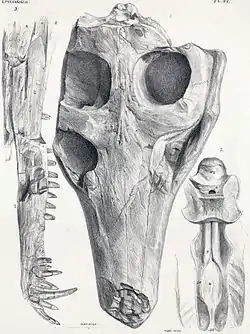Pholidosauridae
Pholidosauridae is an extinct family of aquatic neosuchian mesoeucrocodylian crocodylomorphs. Fossils have been found in Europe (Denmark, England, France, Germany, Spain and Sweden), Africa (Algeria, Niger, Mali, Morocco and Tunisia), North America (Canada and the United States) and South America (Brazil and Uruguay). The pholidosaurids first appeared in the fossil record during the Bathonian stage of the Middle Jurassic. Jouve & Jalil (2020) described postcranial material of a pholidosaurid from the Paleocene (Danian) of Ouled Abdoun Basin (Morocco), representing the most recent record of the family. The authors also reinterpreted putative Maastrichtian dyrosaurid Sabinosuchus as a pholidosaurid, and argued that at least two independent pholidosaurid lineages reached the Maastrichtian, among which one survived the Cretaceous–Paleogene extinction event.[1] Before the publication of this study it was thought that the family became extinct during the Late Turonian stage of the Late Cretaceous.[2]
| Pholidosauridae Temporal range: Late Jurassic - Late Cretaceous, Possible Middle Jurassic (Bathonian) and Paleocene (Danian) records. | |
|---|---|
 | |
| Oceanosuchus | |
| Scientific classification | |
| Domain: | Eukaryota |
| Kingdom: | Animalia |
| Phylum: | Chordata |
| Class: | Reptilia |
| Clade: | Pseudosuchia |
| Clade: | Crocodylomorpha |
| Suborder: | †Tethysuchia |
| Family: | †Pholidosauridae Zittel and Eastman, 1902 |
| Subgroups | |

Sarcosuchus is one of the best known pholidosaurs. It is believed to have attained lengths of up to 9.5 m and weighed up to 4.3 metric tons.[3] Related to Sarcosuchus, Chalawan thailandicus could have reached more than 10 m (33 ft) in length.[4] One genus, Suchosaurus, once thought to be a pholidosaur,[5] has since been shown to be a spinosaurid theropod dinosaur[6] (incertae sedis within Baryonychinae; possibly a junior synonym of Baryonyx[7]). The Cenomanian Terminonaris was the Pholidosaurid species that appeared to be the most common during the Late Cretaceous.[8]
Phylogeny
Pholidosauridae is usually considered to be most closely related to the Dyrosauridae. However, the relationship between these families is not fully understood. Pholidosauridae might be monophyletic,[2] paraphyletic[9] or even a polyphyletic[10] in relation to Dyrosauridae. For example, Fortier, Perea & Schultz (2011) found the family to be monophyletic, and include to main lineages: the Elosuchus–Meridiosaurus lineage and the Pholidosaurus lineage. The cladogram below shows their phylogenetic analysis, which is based on an expanded version of Pol and Gasparini (2009) analysis.[2]
| Neosuchia |
| |||||||||||||||||||||||||||||||||||||||||||||||||||||||||||||||||||||||||||||||||||||||
de Andrade et al. (2011) recovered a paraphyletic traditional Pholidosauridae. In their analysis the "Elosuchus lineage" was found to be basal to the "Pholidosaurus lineage"+Dyrosauridae. They used the name Elosuchidae for the Elosuchus lineage and restricted Pholidosauridae to its type genus. The following cladogram simplified after their analysis.[9]
| Neosuchia |
| |||||||||||||||||||||||||||||||||||||||||||||||||||||||||||||||||||||||||||||||||||||||||||||
References
- Stéphane Jouve; Nour-Eddine Jalil (2020). "Paleocene resurrection of a crocodylomorph taxon: Biotic crises, climatic and sea level fluctuations". Gondwana Research. 85: 1–18. Bibcode:2020GondR..85....1J. doi:10.1016/j.gr.2020.03.010. S2CID 219451890.
- Daniel Fortier, Daniel Perea & Cesar Schultz (2011). "Redescription and phylogenetic relationships of Meridiosaurus vallisparadisi, a pholidosaurid from the Late Jurassic of Uruguay". Zoological Journal of the Linnean Society. 163 (s1): S66–S108. doi:10.1111/j.1096-3642.2011.00709.x.
- Haley D O’Brien, Leigha M Lynch; Kent A Vliet; Brueggen, John; Gregory M Erickson; Paul M Gignac (2019). "Crocodylian Head Width Allometry and Phylogenetic Prediction of Body Size in Extinct Crocodyliforms". Integrative Organismal Biology. 1 (1): obz006. doi:10.1093/iob/obz006. PMC 7671145. PMID 33791523.
- Martin, J. E.; Lauprasert, K.; Buffetaut, E.; Liard, R. & Suteethorn, V. (2013). "A large pholidosaurid in the Phu Kradung Formation of north-eastern Thailand". Palaeontology. 57 (4): 757–769. doi:10.1111/pala.12086. S2CID 128482290.
- Carroll, R.L. 1988. Vertebrate Paleontology and Evolution. WH Freeman and Company, New York ISBN 0-7167-1822-7
- Buffetaut, E. (2007). "The spinosaurid dinosaur Baryonyx (Saurischia, Theropoda) in the Early Cretaceous of Portugal." Geological Magazine, 144(6): 1021-1025.
- Mateus, Octávio; Araújo, Ricardo; Natário, Carlos; Castanhinha, Rui (21 April 2011). "A new specimen of the theropod dinosaur Baryonyx from the early Cretaceous of Portugal and taxonomic validity of Suchosaurus". Zootaxa. 2827 (1): 54–68. doi:10.11646/zootaxa.2827.1.3. ISSN 1175-5334.
- Adams, Thomas L.; Polcyn, Michael J.; Mateus, Octávio; Winkler, Dale A.; Jacobs, Louis L. (1 May 2011). "First occurrence of the long-snouted crocodyliform Terminonaris (Pholidosauridae) from the Woodbine Formation (Cenomanian) of Texas". Journal of Vertebrate Paleontology. 31 (3): 712–716. Bibcode:2011JVPal..31..712A. doi:10.1080/02724634.2011.572938. ISSN 0272-4634. S2CID 86061260.
- Marco Brandalise de Andrade; Richard Edmonds; Michael J. Benton; Remmert Schouten (2011). "A new Berriasian species of Goniopholis (Mesoeucrocodylia, Neosuchia) from England, and a review of the genus". Zoological Journal of the Linnean Society. 163 (s1): S66–S108. doi:10.1111/j.1096-3642.2011.00709.x.
- Bronzati, M.; Montefeltro, F. C.; Langer, M. C. (2012). "A species-level supertree of Crocodyliformes". Historical Biology. 24 (6): 598–606. doi:10.1080/08912963.2012.662680. S2CID 53412111.
External links
- Pholidosauridae at the Paleobiology Database
- Mikko's Phylogeny Archive on Pholidosauridae

